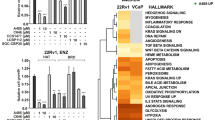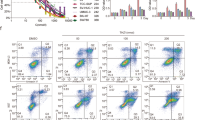Abstract
Inhibitor of DNA binding-1 (Id1) is a dominant-negative regulator of basic helix–loop–helix transcription factor, which control malignant cell behaviors in several types of carcinomas. This study aimed to find the relationship between Id1 expression and some clinical parameters. Paraffin-embedded tissue specimens from two normal human prostates, 12 benign prostatic hyperplasia (BPH), 43 prostate cancers(PCa) were detected by immunofluorescence assay. Prostatectomy samples from 11 BPH and 28 PCa were used for real time RT-PCR. The relationship between Id1 staining and several patient’s clinical parameters, including Gleason grade, PSA, clinical stage, and size of tumor, was further analyzed. Significant up-regulated Id1 protein was shown in prostate cancer specimens, while only weak expression in some BPH samples (5/12). Analyzed by image software, the mean proportion of Id1 positive staining remarkably increased with the increasing of Gleason grade in prostate cancer specimens (r = 0.9967, P < 0.01). Id1 expression was not significantly associated with PSA, TNM stage or tumor size. Furthermore, the average mRNA of prostate cancer was 3.09 times of BPH. This study confirms that Id1 protein and mRNA are over expressed in prostate cancer tissues. Overexpression of Id1 protein correlates with tumor tissue differentiation. We propose that Id1 over expression can be used in the analysis of the progression of prostate cancer.



Similar content being viewed by others
References
Jemal A, Siegel R, Ward E et al (2007) Cancer statistics, 2007. CA Cancer J Clin 57:43–66
Hsing AW, Tsao L, Devesa SS (2000) International trends and patterns of prostate cancer incidence and mortality. Int Cancer 85:60–67, (review)
Sim HG, Cheng CW (2005) Changing demography of prostate cancer in Asia. Eur J Cancer 41:834–845
Gu F (2000) Epidemiological survey of benign prostatic hyperplasia and prostate cancer in China. Chin Med J (Engl) 113:299–302
Hsing AW, Devesa SS, Jin F et al (1998) Rising incidence of prostate cancer in Shanghai. Cancer Epidemiol Biomarkers Prev 7:83–84 (letter)
Hasskarl J, Munger K (2002) Id proteins—tumor marker or oncogenes? Cancer Biology and Therapy 1:91–96 (review)
Perk J, Iavarone A, Benezra R (2005) Id family of helix–loop–helix proteins in cancer. Nat Rev Cancer 5:603–604
Han S, Guo C, Hong L et al (2004) Expression and significance of Id1 helix–loop–helix protein overexpression in gastric cancer. Cancer Lett 216:63–71
Matsuda Y, Yamagiwa S, Takamura M et al (2005) Overexpressed Id-1 is associated with a high risk of hepatocellular carcinoma development in patients with cirrhosis without transcriptional repression of p16. Cancer 104:1037–1044
Straume O, Akslen LA (2005) Strong expression of ID1 protein is associated with decreased survival, increased expression of ephrin-A1/EPHA2, and reduced thrombospondin-1 in malignant melanoma. Br J Cancer 93:933–938
Benezra R, Davis RL, Lockshon D et al (1990) The protein Id: a negative regulator of helix–loop–helix DNA binding proteins. Cell 61:49–59
Alani RM, Hasskarl J, Grace M et al (1999) Immortalization of primary human keratinocytes by the helix–loop–helix protein,Id-1. Proc Natl Acad Sci USA 96:9637–9641
Lyden D, Young AZ, Zagzag D et al (1999) Id1 and Id3 are required for neurogenesis, angiogenesis and vascularization of tumour xenografts. Nature 401:670–677
Ruzinova MB, Benezra R (2003) Id proteins in development, cell cycle and cancer. Trends Cell Biol 13:410–418
Wong YC, Wang X, Ling MT (2004) Id-1 expression and cell survival. Apoptosis 9:279–289, (review)
Jang KS, Han HX, Paik SS et al (2006) Id-1 overexpression in invasive ductal carcinoma cells is significantly associated with intratumoral microvessel density in ER-negative/node-positive breast cancer. Cancer Lett 244:203–210
Chetcuti A, Marqan S, Mann S et al (2001) Identification of differentially expressed genes in organ-confined prostate cancer by gene expression array. Prostate 47:132–140
Ouyang XS, Wang X, Lee DT et al (2002) Overexpression of ID-1 in prostate cancer. J Urol 167:2598–2602
Coppe JP, Itahana Y, Moore DH et al (2004) Id-1 and Id-2 proteins as molecular markers for human prostate cancer progression. Clin Cancer Res 10:2044–2051
Yu DS, Hsieh DS, Chang SY (2006) Increasing expression of GST-pi MIF, and ID1 genes in chemoresistant prostate cancer cells. Arch Androl 52:275–281
Lin JC, Chang SY, Hsieh DS et al (2005) Modulation of mitogen-activated protein kinase cascades by differentiation-1 protein: acquired drug resistance of hormone independent prostate cancer cells. J Urol 174:2022–2026
Ouyang XS, Wang X, Ling MT et al (2002) Id-1 stimulates serum independent prostate cancer cell proliferation through inactivation of p16(INK4a)/pRB pathway. Carcinogenesis 23:721–725
Asirvatham AJ, Schmidt MA, Chaudhary J (2006) Non-redundant inhibitor of differentiation (Id) gene expression and function in human prostate epithelial cells. Prostate 66:921–935
Perk J, Gil-Bazo I, Chin Y et al (2006) Reassessment of id1 protein expression in human mammary, prostate, and bladder cancers using a monospecific rabbit monoclonal anti-id1 antibody. Cancer Res 66:10870–10877
Schindl M, Schoppmann SF, Strobel T et al (2003) Level of Id-1 protein expression correlates with poor differentiation, enhanced malignant potential and more aggressive clinical behavior of epithelial ovarian tumors. Clin Cancer Res 9:779–785
Lin CQ, Singh J, Murata K et al (2000) A role for Id-1 in the aggressive phenotype and steroid hormone response of human breast cancer cells. Cancer Res 60:1332–1340
Ling MT, Wang X, Lee DT et al (2004) Id1 expression induces androgen-independent prostate cancer cell growth through activation of epidermal growth factor receptor (EGF-R). Carcinogenesis 25:517–525
Ling MT, Wanq X, Ouyanq XS et al (2002) Activation of MAPK signaling pathway is essential for Id1 induced serum independent prostate cancer cell growth. Oncogene 21:8498–8505
Ling MT, Wang X, Ouyang XS et al (2003) Id1 expression promotes cell survival through activation of NF-kB signaling pathway in prostate cancer cells. Oncogene 22:4498–4508
Fong S, Itahana Y, Sumida T et al (2003) Id-1 as a molecular target in therapy for breast cancer cell invasion and metastasis. Proc Natl Acad Sci USA 100:13543–13548
Fong S, Debs RJ, Desprez PY (2004) Id genes and proteins as promising targets in cancer therapy. Trends Mol Med 10:387–392 (review)
Tsuchiya T, Okaji Y, Tsuno NH et al (2005) Targeting Id1 and Id3 inhibits peritoneal metastasis of gastric cancer. Cancer Sci 96:784–790
Acknowledgment
This study was supported by the Medical Science Fund (05-1-NS-76) of Qingdao Municipal Science and Technology Commission.
Author information
Authors and Affiliations
Corresponding author
Rights and permissions
About this article
Cite this article
Yu, X., Xu, X., Han, B. et al. Inhibitor of DNA Binding-1 Overexpression in Prostate Cancer: Relevance to Tumor Differentiation. Pathol. Oncol. Res. 15, 91–96 (2009). https://doi.org/10.1007/s12253-008-9096-y
Received:
Accepted:
Published:
Issue Date:
DOI: https://doi.org/10.1007/s12253-008-9096-y




